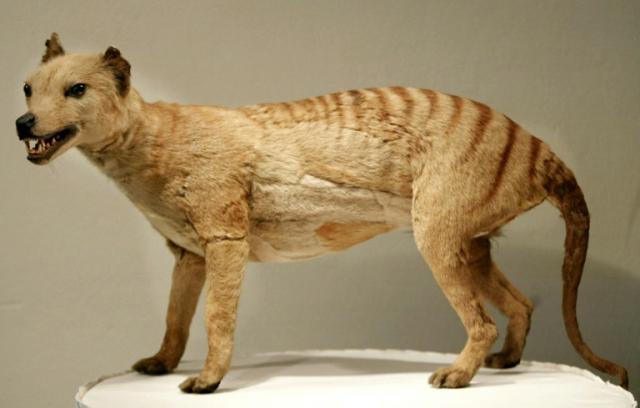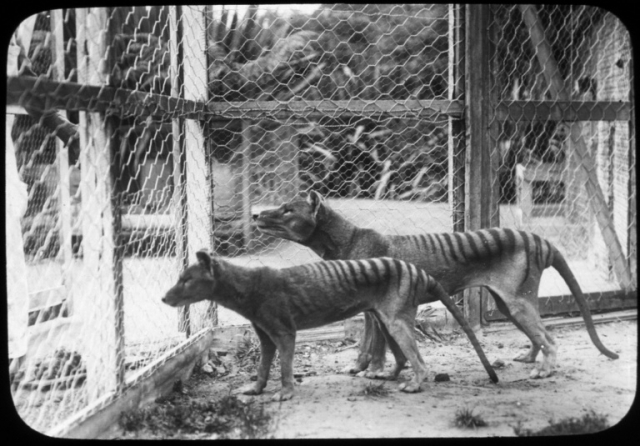Tasmanian tiger just another marsupial in at birth, assume dog-like features outside mother’s pouch

Image: TORSTEN BLACKWOOD – AFP
Australia’s ill-fated Tasmanian tiger looked like any other marsupial when born but assumed dog-like features by the time it left the mother’s pouch, scientists said Wednesday in shedding new light on its puzzling evolution.
Using CT technology, they scanned all 13 juvenile specimens of the extinct carnivore found in collections around the world, developing the first 3D models of the tiger from birth to adulthood.
“These scans show in incredible detail how the Tasmanian tiger started its journey in life as a joey that looked very much like any other marsupial, with robust forearms so that it could climb into its mother’s pouch,” said Christy Hipsley, from Museums Victoria.
“But by the time it left the pouch around 12 weeks to start independent life, it looked more like a dog or wolf, with longer hind limbs than forelimbs.”
Kangaroos, koalas, wombats and the Tasmanian devil are also marsupials.
The animal’s resemblance to the dingo, a wild dog native to Australia, is one of the clearest examples of “convergent evolution” in mammals, which is when two unrelated species evolve to look very similar.

Tasmanian tigers photographed at Beaumaris Zoo in Hobart in Australia’s Tasmania state in 1918. Image: TASMANIAN MUSEUM AND ART GALLERY – TASMANIAN MUSEUM AND ART GALLERY/AFP/File
The Tasmanian tiger last shared a common ancestor with dogs and wolves around 160 million years ago.
Once ranging throughout Australia and New Guinea, Thylacinus cynocephalus disappeared from the mainland around 3,000 years ago, likely due to competition with humans and dogs.
The remaining population — isolated on the island of Tasmania — was hunted to extinction in the early 20th century. The last known individual died at Hobart Zoo in 1936.
The juvenile specimens, representing five stages of postnatal development, were scanned using non-invasive X-ray micro-CT scanning technology to create high-resolution 3D digital models.
University of Melbourne professor Andrew Pask said it was an incredibly effective technique to study the skeletal anatomy of the specimens without causing any damage.
“This research clearly demonstrates the power of CT technology. It has allowed us to scan all the known Thylacine joey specimens in the world, and study their internal structures in high resolution without having to dissect or cause damage to the specimen,” he said.
“By examining their bone development, we’ve been able to illustrate how the Tasmanian tiger matured and identify when they took on the appearance of a dog.”
Museums Victoria had received many requests over the years to dissect its Tasmanian tiger specimens still in the pouch but always refused.
“This new technology enabled us to do research and answer many questions without destruction of the sample specimens,” said its senior curator of vertebrate zoology, Kathryn Medlock.
The study was published in the journal Royal Society Open Science. NVG
RELATED STORIES:
Scientists search for extinct Tasmanian tiger after sightings in Australia
Tasmanian tiger brain scans show it’s a smart hunter, not a scavenger